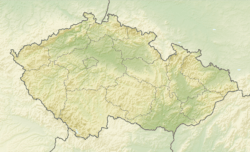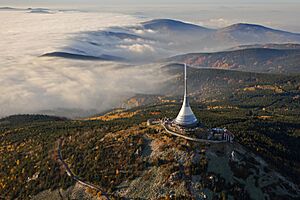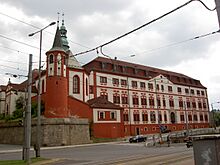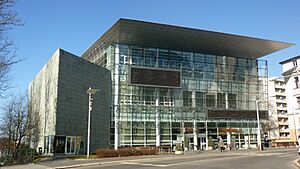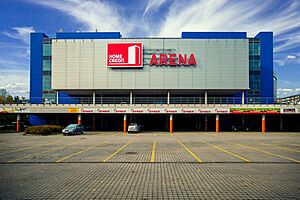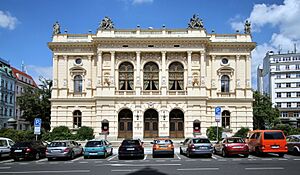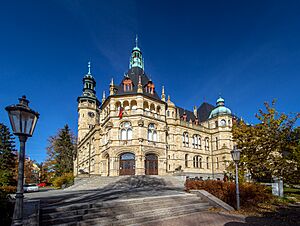Liberec facts for kids
Quick facts for kids
Liberec
|
|||||
|---|---|---|---|---|---|
|
Statutory city
|
|||||
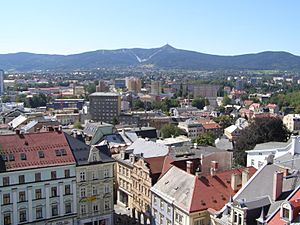
View from the city hall tower
|
|||||
|
|||||
| Country | |||||
| Region | Liberec | ||||
| District | Liberec | ||||
| First mentioned | 1352 | ||||
| Area | |||||
| • Total | 106.09 km2 (40.96 sq mi) | ||||
| Elevation | 374 m (1,227 ft) | ||||
| Population
(2024-01-01)
|
|||||
| • Total | 107,982 | ||||
| • Density | 1,017.83/km2 (2,636.18/sq mi) | ||||
| Time zone | UTC+1 (CET) | ||||
| • Summer (DST) | UTC+2 (CEST) | ||||
| Postal code |
460 01
|
||||
Liberec is a city in the Czech Republic. It has about 108,000 people living there, making it the fifth-largest city in the country. Liberec is located on the Lusatian Neisse river, in a valley surrounded by mountains. The city center is very old and well-kept. It is protected by law as a special historic area.
Liberec was once famous for its busy textile factories. Because of this, people used to call it the "Manchester of Bohemia". For many Czechs, Liberec is best known for its tall Ještěd Tower. Since the late 1800s, Liberec has grown together with nearby towns like Vratislavice nad Nisou and Jablonec nad Nisou.
Contents
City Parts and Divisions
Liberec is made up of 32 different city parts. One of these parts, Vratislavice nad Nisou, even has its own local government.
In the early 1990s, some parts of Liberec became their own separate towns. These include Stráž nad Nisou, Dlouhý Most, Jeřmanice, and Šimonovice.
What Does the Name Liberec Mean?
The oldest names for the city were German, like Reychinberch (from 1352). This name meant "rich mountain" or "mountain with lots of resources."
Over time, the Czech name Liberec came from the German name. It changed from Rychberk (in 1545) to Libercum, then Liberk, and finally Liberec (in 1845). In the Czech language, words that started with "R" sometimes changed to start with "L."
Where is Liberec Located?
Liberec is about 80 kilometers (50 miles) northeast of Prague, the capital of the Czech Republic. Most of the city is in a flat area called the Zittau Basin.
To the northeast, the city's land reaches into the Jizera Mountains. To the west, it extends to the Ještěd–Kozákov Ridge. This ridge includes Ještěd mountain, which is the highest point in Liberec. It stands at 1,012 meters (3,320 feet) above sea level.
Liberec is built on the Lusatian Neisse River. The biggest body of water in the city is the Harcov Reservoir, also called Liberec Dam. This reservoir is inside the city on a stream that flows into the Lusatian Neisse. Today, it's a popular spot for people to relax. It was first built to protect the city from floods and to store water for factories. It's also an important home for protected animals.
Weather in Liberec
Liberec has a climate with warm summers and cold winters. The average temperature for the whole year is about 8.3 degrees Celsius (47 degrees Fahrenheit). July is usually the warmest month, with an average of 18.0 degrees Celsius (64.4 degrees Fahrenheit). January is the coldest, averaging -1.2 degrees Celsius (29.8 degrees Fahrenheit).
The city gets about 845 millimeters (33 inches) of rain each year. July is the wettest month, while April is the driest. The temperature has ranged from a very cold -24.6 degrees Celsius (-12.3 degrees Fahrenheit) in January 1987 to a very hot 36.2 degrees Celsius (97.2 degrees Fahrenheit) in July 1994.
A Look at Liberec's Past
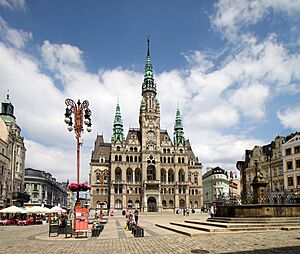
Early Beginnings (11th–16th Centuries)
Around the 11th or 12th century, a settlement called Habersdorf was founded. This was the start of Liberec. It was built on an important trade route that connected Bohemia and Lusatia. Later, another settlement called Reichenberg was built nearby, and the two eventually joined together. The first time Liberec was mentioned in writing was in 1352, under its German name Reichenberg.
From 1278, the Bieberstein family owned the area. Reichenberg faced tough times during the Hussite Wars. It was even burned down in 1469 during a battle. After the Bieberstein family died out, the Redern family bought the land in 1558. The Rederns helped the settlement grow a lot. They built new buildings, made the town more modern, and started the important textile industry. In 1577, Emperor Rudolf II officially made Reichenberg a town. He also gave the town the special coat of arms it still uses today.
Growth and Challenges (17th–19th Centuries)
From 1600, Kateřina of Redern managed the town. She helped the town get the right to trade salt. She also added a chapel to the castle and helped build the town hall. After the Redern family had to leave in 1620, the town was taken over by Albrecht von Wallenstein. Later, it belonged to the Gallas and Clam Gallas families.
The successful local industries faced problems during the Thirty Years' War. A terrible plague also hit the town in 1680. These difficult times led to some rebellions by the local people, but these were stopped.
In the 1700s, Reichenberg became very successful again. The number of people living there tripled, and the cloth industry did very well. A battle between Austria and Prussia happened near the town in 1757 during the Seven Years' War. But the town kept growing. In the 1800s, it became the main center for textile factories in all of Austria-Hungary. In 1850, it became a self-governing city.
By the late 1800s, Reichenberg was a rich industrial city. Many grand buildings were built, like the city hall, the opera house, and the North Bohemian Museum. A beautiful area with large villas, a forest, a botanical garden, and a zoo were also created.
The 20th Century and Beyond
Until 1918, Liberec was part of Austria-Hungary. After World War I, Austria-Hungary broke apart. On October 29, 1918, the Czech people of Bohemia joined the new country of Czechoslovakia. However, the German people in Liberec wanted to stay with Austria. Liberec was even declared the capital of a German-Austrian area. But the Czechs said these lands were always part of Bohemia. On December 16, 1918, the Czechoslovak Army entered Liberec, and the city remained part of Bohemia.
The Great Depression in the 1930s badly hurt the economy of Liberec. Many people lost their jobs, and there was a lot of hunger. This led to the rise of a political party called the Sudeten German Party (SdP). Its leader, Konrad Henlein, was born near Liberec. The city became a center for groups who wanted to join Germany, especially after 1935.
In September 1938, the Munich Agreement gave the city to Nazi Germany. In 1939, it became the capital of a region called Reichsgau Sudetenland. Most of the Jewish and Czech people living in Liberec had to leave or were forced out. The important synagogue was burned down.
After World War II, Liberec became part of Czechoslovakia again. Almost all of the German people in the city were forced to leave. Then, Czech people moved into the area.
Liberec's Economy
Liberec has many important businesses and organizations. Here are some of the largest employers in the city:
| Economic Entity | Number of Employees | Main Activity |
|---|---|---|
| Regional Hospital Liberec | 4,000–4,999 | Health care |
| Denso Manufacturing | 2,000–2,499 | Making car parts |
| Magna Exteriors (Bohemia) | 1,500–1,999 | Making car parts |
| Regional Police Directorate of the Liberec Region | 1,500–1,999 | Public safety and government |
| Technical University of Liberec | 1,000–1,499 | Education and research |
| Webasto Roof & Components Czech Republic | 1,000–1,499 | Making car parts |
The area around Liberec and Jablonec nad Nisou is called the Liberec-Jablonec agglomeration. This area works together to get money from special European funds. About 227,000 people live in this larger area.
Getting Around Liberec
Liberec has a public transport system with bus and tram lines. The first tram in Liberec started running in 1897. Liberec shares a tram line with its neighbor, Jablonec nad Nisou. There are also two city tram lines. One connects Horní Hanychov (near the cable car to Ještěd) and Lidové Sady. The other connects Dolní Hanychov and Lidové Sady. There are also four old, historical trams.
The European route E442 highway passes through Liberec. There is also a private international airport in the Ostašov part of Liberec.
Learning and Science
The Technical University of Liberec was started in 1953. It was first called the "University of Mechanical Engineering in Liberec." In 1995, its name changed because it offered more study areas. It is well-known for its research in textile engineering. The university has about 9,000 students and six different faculties (schools). It also has an Institute for Nanomaterials, Advanced Technologies and Innovation.
The Regional Research Library in Liberec is a public science library. It helps people in the region learn and get general education. It was founded in 1900. The library has a special collection of books and newspapers in German from Bohemia. Its new building was finished in 2000. It was built where the Old Synagogue used to be, which was burned down in 1938. The new building also includes a modern New Synagogue.
Culture and Arts
Mateřinka is a theater festival that happens every two years in June. It's a great event for theater lovers!
Sports in Liberec
Liberec is home to FC Slovan Liberec, a football (soccer) club. They play in the top Czech league and have won three league titles, making them one of the most successful clubs in the Czech Republic. There is also a smaller football club called SK VTJ Rapid Liberec.
The ice hockey team HC Bílí Tygři Liberec plays in the top national league, the Czech Extraliga. They play their games at the Home Credit Arena.
Liberec has hosted two European Luge Championships (in 1914 and 1939). In 2009, it hosted the FIS Nordic World Ski Championships. The Ski Jumping World Cup also comes to Liberec every January. In May 2011, the World Karate Championships were held here.
In 2015, Liberec hosted the World Mountain Bike Orienteering Championships.
Motorcycle speedway races happen at the Pavlovický Stadion. This stadium was built in 1930. A big event held there was the semi-final of the Under-21 World Championship in 2019. The team Start Gniezno Liberec races at this stadium.
Places to See in Liberec
The most famous landmark and symbol of Liberec is the Ještěd Tower. It stands on Ještěd mountain and is used as a TV and radio transmitter, an observation tower, and even a hotel. It was built between 1966 and 1973 by architect Karel Hubáček. It is a very important building in the city and has won many awards for its design.
One of the most beautiful buildings in the city center is the Liberec City Hall. It was built in the Neo-Renaissance style between 1888 and 1893. It has three towers, with the tallest one being 61 meters (200 feet) high. During the summer, you can visit the inside and climb one of the towers. Since 2024, it has been protected as a national cultural monument.
The Liberec Castle was built in different stages, with the oldest part from 1582–1583. After World War II, it was in bad shape. It was later rebuilt and used by a glass company. The castle has not been used since 1997 and is slowly falling apart.
The F. X. Šalda Theatre is another important building. It was built in the Neo-Renaissance style between 1881 and 1883. A special part of the theater is its curtain, which shows the "Triumph of Love." It was made by famous artists Gustav Klimt, Ernst Klimt, and Franz von Matsch.
The North Bohemian Museum was started in 1873. It was the first museum of arts and crafts in the Czech lands. The current museum building was finished in 1898. It has a 41-meter (135-foot) tall tower, which looks like a smaller version of the Liberec City Hall tower.
Liberecká výšina is a famous landmark in the eastern part of the city. It's a restaurant with a 25-meter (82-foot) tall observation tower. It looks like a medieval castle and was built in 1900–1901. Its design was inspired by a watchtower at the Nuremberg Castle.
The most popular places for tourists in Liberec are the Liberec Zoo, iQ Landia (a science center), and Centrum Babylon. Centrum Babylon is a fun place with a big water park, an amusement park, a casino, shops, and a hotel.
Liberec Zoo and Botanical Garden

The Liberec Zoo was founded in 1904. It is the oldest zoo in what used to be Czechoslovakia. Today, it covers almost 14 hectares (35 acres) and has more than 160 different kinds of animals. The most famous animals at the zoo are the white tigers. However, these are a special bred form of the mainland Asian tiger, not a separate species. The zoo plans to stop breeding them after the last one passes away.
The Botanical Garden Liberec was started in 1876 by a group called the "Society of Friends of Nature." It is the oldest botanical garden in the Czech Republic. It was first located where the North Bohemian Museum is now. But it moved in 1895 when the museum was built. Between 1996 and 2000, it was completely rebuilt. Today, it has nine glasshouses for visitors. These glasshouses cover 4,002 square meters (43,077 square feet) and are home to over 8,000 different exotic plants.
Famous People from Liberec
- Ferdinand Porsche (1875–1951), a famous car designer
- Vlasta Burian (1891–1962), a well-known actor
- Konrad Henlein (1898–1945), a German politician
- Otfried Preußler (1923–2013), a German writer
- Barbara Bouchet (born 1944), a German-American actress
- Oldřich Kaiser (born 1955), an actor
- Petr Nedvěd (born 1971), an ice hockey player
- Tomáš Enge (born 1976), a racing driver
- Zuzana Hejnová (born 1986), an athlete
Sister Cities
Liberec has sister city relationships with other cities around the world. This means they share cultural and educational ties.
 Amersfoort, Netherlands
Amersfoort, Netherlands Augsburg, Germany
Augsburg, Germany Nahariya, Israel
Nahariya, Israel Zittau, Germany
Zittau, Germany
Images for kids
See also
 In Spanish: Liberec para niños
In Spanish: Liberec para niños




